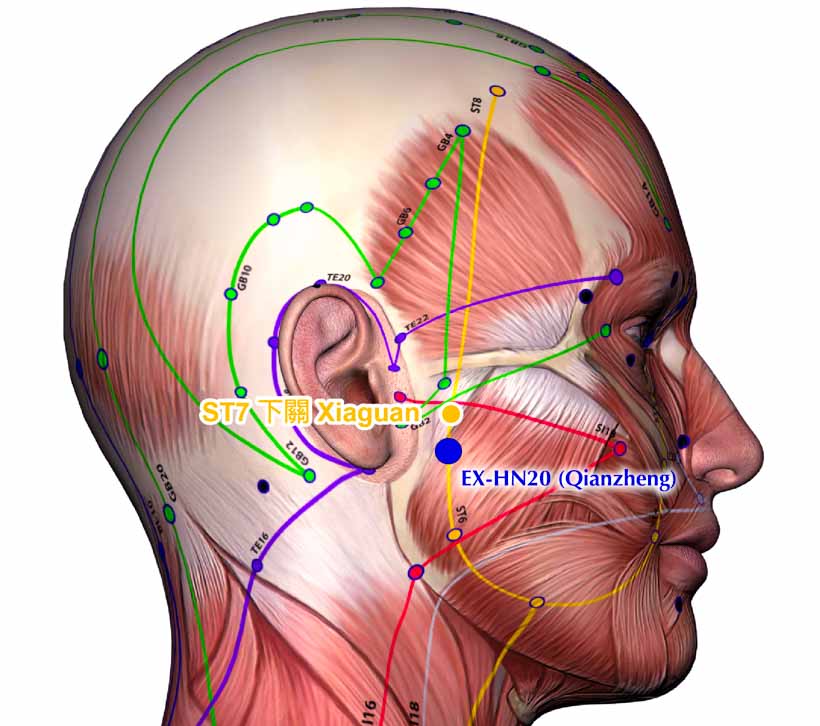Acupuncture is effective for the treatment of peripheral facial paralysis. Researchers in the Department of Rehabilitation Medicine at Yangchun People’s Hospital conducted a trial comparing early-stage acupuncture treatment of peripheral facial paralysis to late-stage acupuncture treatment. The results indicate that earlier treatment increases patient outcomes more significantly.
The study selected 67 patients with peripheral facial paralysis that were divided into two groups. [1] The late-stage group included 33 patients, while the early-stage group included 34 patients. The acupuncture treatment protocol was the same for both groups. Patients were advised to lie supine with their heads slightly turned towards the healthy side. The primary acupoints used were the following:
- LI4 (Hegu)
- GB14 (Yangbai)
- EX-HN20 (Qianzheng)
- ST6 (Jiache)
- ST2 (Sibai)
- GB20 (Fengchi)
- ST4 (Dicang)
Auxiliary acupoints included EX-HN4 (Yuyao), GV26 (Shuigou), ST7 (Xiaguan), GB2 (Tinghui), LI20 (Yingxiang), SI18 (Quanliao), BL2 (Cuanzhu), CV24 (Chengjiang), and TB17 (Yifeng). The acupuncture needles used were gauge 28, 1.5 in. The reducing method was used for the acupoints LI4 and GB20, and the even reinforcing-reducing method was used for the other acupoints.
The needles were retained for 30 minutes. Moxibustion was performed on EX-HN20 (0.5–1.0 cun anterior to the auricular lobe) using a moxa stick daily for 30 minutes each time. The control group received late acupuncture treatment (acupuncture was performed 1–3 days after onset instead of immediately after onset). Both groups completed four courses of treatment, with one course being five days of consecutive treatment. A 2–3 day interval separated each course.
The early stage treatment group’s total clinical efficacy rate was significantly higher at 94.12% than that of the late stage treatment group’s at 75.76%. The early-stage treatment group’s scores in social function, physical function, psychological function, and material living were all significantly higher than those of the control group.
Muscle paralysis is a common clinical condition. When peripheral facial paralysis occurs, patients may exhibit varying degrees of symptoms on the affected side, including disappearance or lightening of forehead wrinkles, weakness or even inability to close the eyelids fully (resulting in exposed sclera), shallowing of the nasolabial fold, deviation of the philtrum and mouth corner, and facial asymmetry symptoms such as stray air leakage when blowing air. Traditional Chinese Medicine (TCM) theory suggests that the causes of this disease are often due to deficiency in the meridians, loss of defensive yang, and invasion of the facial meridians by pathogenic wind and cold, leading to obstructed meridian qi and impaired circulation of blood and qi.
Early treatment significantly improves microcirculation around the facial lesions, which is highly beneficial for patient recovery. It gradually stabilizes symptoms of facial muscle paralysis and restores autonomic nerve regulation functions sooner. Implementing acupuncture in the early stage of the disease directly affects the local nerves, rapidly alleviating swelling and thereby relieving symptoms of facial paralysis. For patients with peripheral facial paralysis, early acupuncture treatment can further improve clinical outcomes and enhance the quality of life.
Reference:
[1] Chen Meixiao, Yi Zhe & Liang Qi. (2021). Evaluation of the clinical value of acupuncture treatment for patients with peripheral facial paralysis at different periods. Medical Diet Therapy and Health (11), 72-73+75.


